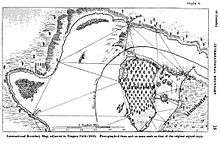Horseshoe Falls
| Horseshoe Falls | |
|---|---|
| Canadian Falls | |
 | |
| Location | Border of Ontario, Canada, and New York, United States |
| Coordinates | Coordinates: 43°04′38″N 79°04′32″W / 43.077305°N 79.07562°W |
| Type | Cataract |
| Total height | 167 ft (51 m)[1] |
| Total width | 2,700 ft (820 m)[1] |
| Watercourse | Niagara River |
Horseshoe Falls, also known as Canadian Falls, is one of three waterfalls which collectively form Niagara Falls on the Niagara River along the Canada-US Border. Approximately 90% of the Niagara River, after diversions for hydropower generation, flows over Horseshoe Falls. The remaining 10% flows over American Falls and Bridal Veil falls. It is located between Terrapin Point on Goat Island in the US state of New York, and Table Rock in the Canadian province of Ontario.[2][3][4]
International border

When the boundary line between the United States and Canada was determined in 1819, based on the Treaty of Ghent, the northeastern end of the Horseshoe Falls was in New York, United States, flowing around the Terrapin Rocks, which was once connected to Goat Island by a series of bridges. In 1955, the area between the rocks and Goat Island was filled in, creating Terrapin Point.[5] In the early 1980s the United States Army Corps of Engineers filled in more land and built diversion dams and retaining walls to force the water away from Terrapin Point. Altogether, 400 feet (120 m) of the Horseshoe Falls was eliminated. Due to erosion, the falls will continue to move in relation to the boundary line in the future.
The official national maps for both Canada and the United States indicate that a small portion of the Horseshoe Falls is located within the United States.[6][7]
Gallery
 Horseshoe Falls at night
Horseshoe Falls at night Horseshoe Falls, viewed from Table Rock Centre in Niagara Falls, Ontario
Horseshoe Falls, viewed from Table Rock Centre in Niagara Falls, Ontario View from beside and behind Horseshoe Falls
View from beside and behind Horseshoe Falls
See also
References
| Wikimedia Commons has media related to Horseshoe Falls. |
- 1 2 "Niagara Falls". World Waterfalls Database. Retrieved 28 January 2017.
- ↑ Staff report (June 23, 2006). Campaign blunder puts Yankee spin on Canada's national anthem. Archived June 28, 2011, at the Wayback Machine. Regina Leader-Post
- ↑ Lee, Matthew (October 29, 2007). Video claims Horseshoe Falls for U.S. Toronto Star
- ↑ "The international boundary line may pass through the Horseshoe Falls just beyond Terrapin Tower Point, so that the United States are not entitled to as large a portion as Canada of the Horseshoe Falls, which is admittedly not all Canadian." Statement of Mr. J Boardman Scovell. Preservation of Niagara Falls: hearings on the subject of H.R. 26688, Sixty-first Congress, second session, relating to the control and regulation of the waters of Niagara River and the preservation of Niagara Falls, held before the Committee on Rivers and Harbors of the House of Representatives. U.S. G.P.O., 1911
- ↑ Berton, Pierre (2009). Niagara: A History of the Falls. SUNY Press. pp. 20–21. ISBN 978-1-4384-2928-1. Retrieved December 1, 2010.
- ↑ "The Atlas of Canada". Government of Canada. Retrieved February 19, 2017.
- ↑ "National Map of the United States". United States Geological Survey. Retrieved February 19, 2017.